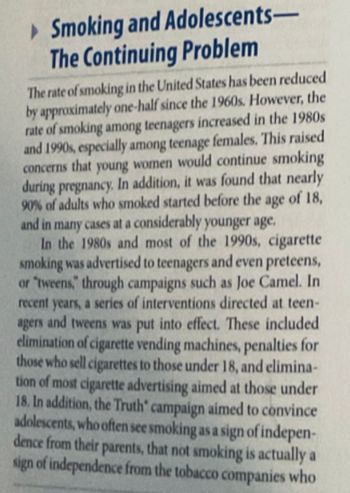seek to control their behavior. Evaluation studies con cluded that these interventions have worked to reduce adolescent smoking by about one-third. Despite the successes of the early years of the 2000s in lowering the rates of cigarette smoking among ado lescents, the rates have now stabilized at over 20%. Evi dence indicates that adolescents who smoke generally do not participate in athletics, more often live in rural areas, and are more often white and less often African American. Males and females smoke about the same amount overall, but white females smoke more and Asian females smoke less than their male counterparts. New drugs taken as pills have recently been shown to increase the rates of success in smoking cessation among adults despite side effects. This is not the situ ation in adolescents because of increased potential for adverse effects, including suicide. A series of interven tions has been suggested for addressing the continu ing problem of adolescent smoking. These include: ☐ Expulsion from school for cigarette smoking Focus on adolescents in tobacco warning labels Selective use of nicotine gum and patches to help with withdrawal M . No smoking rules for sporting events, music con- certs, and other adolescent-oriented events. Fines for adolescents who falsify their age and purchase cigarettes Higher taxes on tobacco products Rewards to students in schools with the lowest smoking rates in a geographic area Higher auto insurance premiums for adolescents. who smoke B - ■ Application of technology to reduce the quantity of nicotine allowed in tobacco products to reduce the potential for addiction Testing of athletes for nicotine and exclusion from competition if they test positive Provision of tobacco counseling as part of medical care covered through insurance The National Academy of Medicine has recom mended that the age for purchase of cigarettes be raised from 18 to 21 years." die Questions ►Smoking and Adolescents- The Continuing Problem The rate of smoking in the United States has been reduced by approximately one-half since the 1960s. However, the rate of smoking among teenagers increased in the 1980s and 1990s, especially among teenage females. This raised concerns that young women would continue smoking during pregnancy. In addition, it was found that nearly 90% of adults who smoked started before the age of 18, and in many cases at a considerably younger age. In the 1980s and most of the 1990s, cigarette smoking was advertised to teenagers and even preteens, or "tweens," through campaigns such as Joe Camel. In recent years, a series of interventions directed at teen- agers and tweens was put into effect. These included. elimination of cigarette vending machines, penalties for those who sell cigarettes to those under 18, and elimina- tion of most cigarette advertising aimed at those under 18. In addition, the Truth' campaign aimed to convince adolescents, who often see smoking as a sign of indepen- dence from their parents, that not smoking is actually a sign of independence from the tobacco companies who
seek to control their behavior. Evaluation studies con cluded that these interventions have worked to reduce adolescent smoking by about one-third. Despite the successes of the early years of the 2000s in lowering the rates of cigarette smoking among ado lescents, the rates have now stabilized at over 20%. Evi dence indicates that adolescents who smoke generally do not participate in athletics, more often live in rural areas, and are more often white and less often African American. Males and females smoke about the same amount overall, but white females smoke more and Asian females smoke less than their male counterparts. New drugs taken as pills have recently been shown to increase the rates of success in smoking cessation among adults despite side effects. This is not the situ ation in adolescents because of increased potential for adverse effects, including suicide. A series of interven tions has been suggested for addressing the continu ing problem of adolescent smoking. These include: ☐ Expulsion from school for cigarette smoking Focus on adolescents in tobacco warning labels Selective use of nicotine gum and patches to help with withdrawal M . No smoking rules for sporting events, music con- certs, and other adolescent-oriented events. Fines for adolescents who falsify their age and purchase cigarettes Higher taxes on tobacco products Rewards to students in schools with the lowest smoking rates in a geographic area Higher auto insurance premiums for adolescents. who smoke B - ■ Application of technology to reduce the quantity of nicotine allowed in tobacco products to reduce the potential for addiction Testing of athletes for nicotine and exclusion from competition if they test positive Provision of tobacco counseling as part of medical care covered through insurance The National Academy of Medicine has recom mended that the age for purchase of cigarettes be raised from 18 to 21 years." die Questions ►Smoking and Adolescents- The Continuing Problem The rate of smoking in the United States has been reduced by approximately one-half since the 1960s. However, the rate of smoking among teenagers increased in the 1980s and 1990s, especially among teenage females. This raised concerns that young women would continue smoking during pregnancy. In addition, it was found that nearly 90% of adults who smoked started before the age of 18, and in many cases at a considerably younger age. In the 1980s and most of the 1990s, cigarette smoking was advertised to teenagers and even preteens, or "tweens," through campaigns such as Joe Camel. In recent years, a series of interventions directed at teen- agers and tweens was put into effect. These included. elimination of cigarette vending machines, penalties for those who sell cigarettes to those under 18, and elimina- tion of most cigarette advertising aimed at those under 18. In addition, the Truth' campaign aimed to convince adolescents, who often see smoking as a sign of indepen- dence from their parents, that not smoking is actually a sign of independence from the tobacco companies who
Oh no! Our experts couldn't answer your question.
Don't worry! We won't leave you hanging. Plus, we're giving you back one question for the inconvenience.
Submit your question and receive a step-by-step explanation from our experts in as fast as 30 minutes.
You have no more questions left.
Message from our expert:
Your Preventive Medicine question does not match the subject you selected. Please ask a question in one of the 30+ subjects available. We've credited a question to your account.
Your Question:
How would you classify each of these potential interventions as education (information), motivation (incentives), obligation (required), or innovation (technological change) ?

Transcribed Image Text:seek to control their behavior. Evaluation studies con
cluded that these interventions have worked to reduce
adolescent smoking by about one-third.
Despite the successes of the early years of the 2000s
in lowering the rates of cigarette smoking among ado
lescents, the rates have now stabilized at over 20%. Evi
dence indicates that adolescents who smoke generally
do not participate in athletics, more often live in rural
areas, and are more often white and less often African
American. Males and females smoke about the same
amount overall, but white females smoke more and
Asian females smoke less than their male counterparts.
New drugs taken as pills have recently been shown
to increase the rates of success in smoking cessation
among adults despite side effects. This is not the situ
ation in adolescents because of increased potential for
adverse effects, including suicide. A series of interven
tions has been suggested for addressing the continu
ing problem of adolescent smoking. These include:
☐ Expulsion from school for cigarette smoking
Focus on adolescents in tobacco warning labels
Selective use of nicotine gum and patches to help
with withdrawal
M
.
No smoking rules for sporting events, music con-
certs, and other adolescent-oriented events.
Fines for adolescents who falsify their age and
purchase cigarettes
Higher taxes on tobacco products
Rewards to students in schools with the lowest
smoking rates in a geographic area
Higher auto insurance premiums for adolescents.
who smoke
B
-
■
Application of technology to reduce the quantity
of nicotine allowed in tobacco products to reduce
the potential for addiction
Testing of athletes for nicotine and exclusion from
competition if they test positive
Provision of tobacco counseling as part of medical
care covered through insurance
The National Academy of Medicine has recom
mended that the age for purchase of cigarettes be
raised from 18 to 21 years."
die
Questions

Transcribed Image Text:►Smoking and Adolescents-
The Continuing Problem
The rate of smoking in the United States has been reduced
by approximately one-half since the 1960s. However, the
rate of smoking among teenagers increased in the 1980s
and 1990s, especially among teenage females. This raised
concerns that young women would continue smoking
during pregnancy. In addition, it was found that nearly
90% of adults who smoked started before the age of 18,
and in many cases at a considerably younger age.
In the 1980s and most of the 1990s, cigarette
smoking was advertised to teenagers and even preteens,
or "tweens," through campaigns such as Joe Camel. In
recent years, a series of interventions directed at teen-
agers and tweens was put into effect. These included.
elimination of cigarette vending machines, penalties for
those who sell cigarettes to those under 18, and elimina-
tion of most cigarette advertising aimed at those under
18. In addition, the Truth' campaign aimed to convince
adolescents, who often see smoking as a sign of indepen-
dence from their parents, that not smoking is actually a
sign of independence from the tobacco companies who
Recommended textbooks for you

Biochemistry
Biochemistry
ISBN:
9781305577206
Author:
Reginald H. Garrett, Charles M. Grisham
Publisher:
Cengage Learning

Biology (MindTap Course List)
Biology
ISBN:
9781337392938
Author:
Eldra Solomon, Charles Martin, Diana W. Martin, Linda R. Berg
Publisher:
Cengage Learning

Human Heredity: Principles and Issues (MindTap Co…
Biology
ISBN:
9781305251052
Author:
Michael Cummings
Publisher:
Cengage Learning

Biochemistry
Biochemistry
ISBN:
9781305577206
Author:
Reginald H. Garrett, Charles M. Grisham
Publisher:
Cengage Learning

Biology (MindTap Course List)
Biology
ISBN:
9781337392938
Author:
Eldra Solomon, Charles Martin, Diana W. Martin, Linda R. Berg
Publisher:
Cengage Learning

Human Heredity: Principles and Issues (MindTap Co…
Biology
ISBN:
9781305251052
Author:
Michael Cummings
Publisher:
Cengage Learning

Nutrition: Concepts and Controversies - Standalo…
Health & Nutrition
ISBN:
9781305627994
Author:
Frances Sizer, Ellie Whitney
Publisher:
Brooks Cole

Anatomy & Physiology
Biology
ISBN:
9781938168130
Author:
Kelly A. Young, James A. Wise, Peter DeSaix, Dean H. Kruse, Brandon Poe, Eddie Johnson, Jody E. Johnson, Oksana Korol, J. Gordon Betts, Mark Womble
Publisher:
OpenStax College

Case Studies In Health Information Management
Biology
ISBN:
9781337676908
Author:
SCHNERING
Publisher:
Cengage
